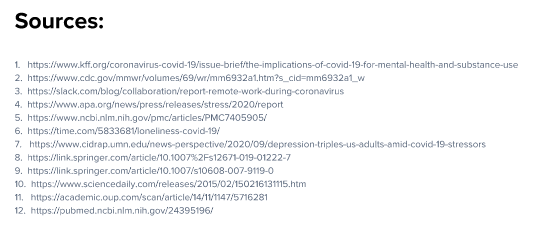9 Mindfulness Exercises to Help you Manage COVID Stress

By Amy Rigby, guest contributor
Mindfulness exercises are the gold standard for managing COVID stress for a reason.
53% of adults in the U.S. say their mental health has worsened because of Covid-related stress and worry.From the pandemic that brought you the terms “social distancing” and “Zoom fatigue,” here’s another one to add to your vocabulary: Covid stress. Google Trends shows that searches for the term were nonexistent in February, peaked at the end of March, fell at the start of summer and were again on the rise as we headed into winter.
11 statistics on managing COVID stress that show the pandemic’s mental health toll
5 promising statistics on mindfulness exercises
“Mindfulness is the idea of learning how to be fully present and engaged in the moment, aware of your thoughts and feelings without distraction or judgment.”
1. Mindfulness may reduce stress.
Participants who did eight weeks of a guided body scan mindfulness practice showed decreased signs of biological stress compared to participants who listened to an audiobook. [8]2. Mindfulness meditation may help decrease dwelling on negative thoughts.
Twenty novice meditators took part in a 10-day intensive mindfulness meditation retreat. Compared to the control group, which did not do any meditation training, these 20 meditators showed decreases in rumination and depressive symptoms. [9]3. Mindfulness meditation may help you sleep better.
A study of older adults (average age of 66) looked at two groups: One group completed a mindful awareness practices (MAPs) intervention, while the other completed a sleep hygiene education (SHE) intervention.4. Mindful acceptance may reduce feelings of pain and negative emotions.
A study published in 2019 tested how mindfulness training might affect emotional regulation in people who don't meditate. Researchers subjected participants to negative images and painful temperatures and asked them to either react as they normally would or practice mindfully accepting what was happening.5. Mindfulness meditation may reduce anxiety and depression.
A literature review of 47 trials and 3,515 participants found that mindfulness meditation displayed “moderate evidence” of improving anxiety and depression. [12]9 effective mindfulness exercises to try today
1. The big shrug
“If you've ever been stuck in traffic and noticed you were gripping the steering wheel tight, or your shoulders were creeping up to your ears, you know what it's like to have your body react to stress,” says Dr. Nicole Byers, a clinical neuropsychologist in Alberta. “When our bodies react with tension, this signals our brains there is a reason to be stressed, which keeps our minds racing with worry and puts our brains on high alert.”Dr. Byers has a favorite mindfulness exercise to ease this pent-up tension.
- Sit with your feet flat on the floor and your hands in your lap.
- Close your eyes.
- Focus on the muscles in your shoulders and neck, where many of us hold stress. Notice how they feel.
- Tighten your shoulders, bringing them as close to your ears as possible. Think of it as a big shrug.
- Hold this position while counting to five. As you count, notice the feeling in your shoulders.
- Relax and drop your shoulders as low as you can. Focus on how different your shoulders feel now.
- Repeat this five times.
2. The four questions
Kathryn Ely, a national certified counselor in Alabama, does the following mindfulness routine every morning, which she also recommends to her clients. Before beginning the day, she asks herself these four questions:- How do I want to show up to those I love today?
- How do I want to treat myself today?
- What do I want to accomplish today?
- What actions will it take to accomplish this?
3. Thoughts as clouds
Sometimes, our stress is caused by rumination—being unable to let go of a negative thought that distresses us. Other times, it’s the opposite—a thought is so distressing to us that we try to push it out of our mind, only to find that it won’t go away.So how can you prevent your thoughts from ruling over you?
“I encourage clients to distinguish between the thoughts and feelings they’re having about a situation and the reality of that situation,” says Jennifer Hamady, a therapist and performance coach.
She recommends the following exercise.
- Turn off your phone.
- Sit comfortably.
- Close your eyes or gaze at a fixed point.
- Observe your thoughts as though they were clouds in the sky. “I ask [my clients] to view them as external entities, as clouds passing over a mountain,” explains Hamady, “which helps to reinforce the idea that our thoughts and feelings come and go, largely involuntarily. They are not who we are.”
4. Sensory toolkit
Mindfulness doesn’t always involve sitting with your eyes closed. This fun and interactive mindfulness exercise is recommended by Melissa Wesner, a licensed clinical professional counselor in Maryland.Create a sensory toolkit, complete with calming items that involve each of your five senses. Need ideas? Wesner offers these suggestions:
- Sight: A picture of your friend, pet, or child; a meaningful card; an email; an affirmation.
- Smell: Lavender oil, scented candle, lotion
- Hearing: Nature sounds, your favorite song
- Taste: Peppermint gum, your favorite tea, ginger hard candy
- Touch: Kinetic sand, silly putty, Play-Doh, a smooth stone
5. One-minute breathing exercise
“We don't always recognize it, but when we feel internal or external conflict, like that which comes from stress, our body kicks into the ‘fight or flight’ mode,” says Jason Wilkinson, a marriage and family therapist in Oregon. “One of our body’s reactions is to start taking short, shallow breaths. This increases the tension in our body, which is one cause for increased anxiety.”His favorite mindful way to combat that reaction is this quick breathing exercise:
- Breathe in through your nose for four seconds.
- Hold your breath for two seconds.
- Exhale for six seconds.
- Repeat five times.
6. Mindful acceptance
Earlier, you learned that a 2019 study found that mindful acceptance decreased pain and negative emotions. Remember, the participants were shown aversive pictures or subjected to painful temperatures and were instructed to accept the negative feelings as they came.In the instructions given to them, the participants read this analogy:
“Suppose there is a bus and you're the driver. On this bus there are a number of passengers. The passengers are your thoughts. Furthermore, assume for the moment that all the passengers riding on your bus are intimidating, and each is yelling directions about where you have to go. "You've got to turn left," "You've got to go right," and so on. The threat they have over you is that if you don't do what they say, they're going to come up front from the back of the bus and start trouble. So you feel as though you must obey these passengers and follow their directions to avoid trouble.”The instructions said that, just like passengers on a bus, negative feelings and thoughts are temporary. They arrive, and then they leave. Instead of fighting with the passengers (or your thoughts and feelings), accept them as they are. They will eventually go away.
So the next time you’re experiencing something unpleasant—a noisy house while you’re trying to work or a rude email, for example—give this evidence-based exercise a try. Rather than fighting your negative feelings, accept them, recognizing that they are only temporary passengers.
7. Body scan
This next mindfulness exercise comes from Dr. Afrosa Ahmed, a medical doctor and mindfulness coach in the UK. She uses this with her clients, followed by some reflection work.- Lie down with a cushion underneath your head for support. Dr. Ahmed does not recommend doing this in your bed since you might fall asleep. Opt for a couch instead.
- Close your eyes and focus on your breath.
- Focus on each part of your body, starting from your feet and working your way up. Continue breathing in and out.
- As you scan your body, pay attention to any part that feels tense. Breathe into those.
- You’ll end the practice after focusing on your head.
- The entire exercise should take 20 minutes.
8. 5-4-3-2-1 grounding exercise
Have you ever gotten so stressed out about something that you hardly noticed anything around you? Next time that happens, try a grounding exercise to help you return your focus to the present moment and reality. Here’s one recommended by Grace Dowd, a licensed psychotherapist in Texas.“This exercise helps people get out of their heads and into their environment by focusing on their five senses,” she explains. “It also taps into our parasympathetic ‘rest and digest’ part of our nervous system.”
- Take a few deep breaths and settle into your body.
- Name five things you can see.
- Four things you can touch.
- Three things you can hear.
- Two things you can smell.
- One thing you can taste.
- Continue breathing deeply.
- Repeat as necessary.
9. Hobbies
How about just doing something fun as an act of being mindful? According to Stephanie Korpal, a therapist in Missouri, hobbies are a perfectly legitimate way to bring yourself back to the present moment.“Hobbies are usually mindfulness activities,” she says. “They just haven’t always been called that. I encourage clients to walk through Michael’s, or Hobby Lobby, or any other craft store and see what catches their eye and try it out. Learning about new enjoyable hobbies can be fun, and it all leads to the opportunity for mindfulness.”
Be mindful, be kind, be well
As you can see, mindfulness exercises are a free and simple way to get some relief from Covid stress. As the research has shown, there is evidence that this practice can reduce biological signs of stress, decrease feelings of pain and even help you sleep better.
While mindfulness exercises may be able to provide stress relief during these trying times, they are not a cure-all. Mindfulness won’t make very real problems—a global pandemic, job insecurity, an economic recession—go away. It simply gives you a tool to cope with what you cannot control.
As the National Institute of Health website advises, “Don’t use meditation to replace conventional care or as a reason to postpone seeing a health care provider about a medical problem.”
Stress affects everyone differently. Its symptoms can be physical and psychological. So be sure to connect with a doctor or a therapist who can help you if you need it. You might check your organization’s employee assistance program to see what mental health resources it can provide. Another great resource is online therapy since you can attend sessions virtually during the pandemic. BetterHelp and Talkspace are both options I’ve used this year.
These days, we all need a little extra help. Reaching out for assistance is a brave thing to do, and it’s the only way we’ll all get through this pandemic together. In the meantime, let’s look forward to the day when the term “Covid stress” is no longer needed.
Amy Rigby is a freelance writer who shares evidence-based advice that helps you do your best work. Since 2013, she's scaled and exited a content business and helped startups across the globe win over customers through the power of the written word. You can find more of her articles in places like Trello, GoDaddy and Foundr.
This article was previously published on Fingerprint for Success.
--
This article does not provide medical advice. Please consult with a physician or other licensed health care professional if you’re experiencing mental or physical distress. Below are some resources for you:
- If you’re in danger, call 911.
The following crisis support services are completely free and operate 24 hours a day, seven days a week:
- National Suicide Prevention Lifeline: 1-800-273-8255
- Disaster Distress Helpline: 1-800-985-5990
- Crisis Text Line: Text HOME to 741741


0 comments
Leave a comment